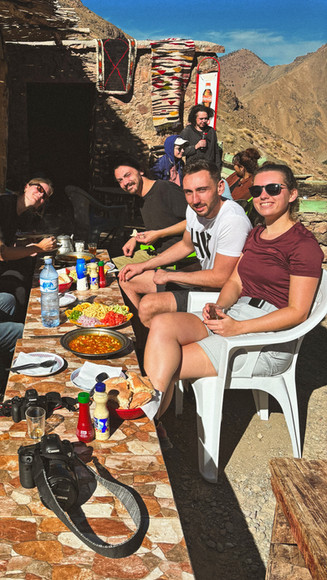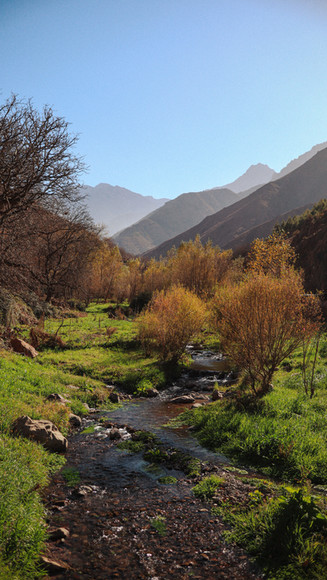Morocco: Two-day hike in the Atlas Mountains
- Oscar & Marjolein

- Jan 9, 2024
- 5 min read
A two-day hike through the Atlas Mountains is a unique experience that takes you past traditional Berber villages, impressive mountain passes, and beautiful valleys. In this blog, we share our experiences and give practical tips for anyone who wants to experience this unforgettable adventure for themselves.

What should you bring on a hike in the Atlas Mountains?
When hiking in the Atlas Mountains, it is important to be well prepared. Here is a handy list of essential items that we recommend bringing with you:
Hiking boots: sturdy, well-broken-in hiking boots with good grip for rough terrain.
Hiking poles: hiking poles provide extra support, especially during steep climbs and descents. They help you maintain your balance and relieve pressure on your knees.
Water: bring enough water. You will be given drinks during lunch, but it is a good idea to carry your own water with you for the rest of the day. We use a Hydro bag that we carry in our backpacks.
Layers of clothing: the weather can change quickly, so wear breathable clothing in layers. We did this hike in January, when it was cold in the morning and warm when the sun came out.
Snacks: breakfast, lunch, and dinner are provided by the organization. However, energy-rich snacks for in between meals are sometimes welcome. These are also available in the souks in Marrakesh: dates, nuts, and dried fruit.
Backpack: you can leave your heavy luggage with the mules. You will only see these items again at the guesthouse where you spend the night. You can bring a backpack for the items you need along the way.
First aid kit: a small first aid kit with (blister) plasters, medicines, disinfectant, and tweezers. The latter will come in handy if, for example, you grab a cactus with your hand and need to remove the needles.
Power bank: make sure your phone stays charged for emergencies and photos.
Cash: there is no access to ATMs in the mountains and Berber villages, so bring some cash for small purchases.
Best time to visit the Atlas Mountains
The best time to visit the Atlas Mountains depends on the type of adventure you are looking for. For pleasant temperatures and ideal hiking conditions, spring (April to June) and fall (September to November) are the best times to visit. The weather is mild, with cool mornings and sunny afternoons, perfect for hiking.
We were there in January, and although it can normally be quite cold, especially at higher altitudes, 2024 was an exceptional year. There was surprisingly little snow compared to previous winters, and daytime temperatures were pleasantly warm. This made it ideal for hiking, as the trails were easily passable without having to trudge through thick layers of snow. However, the evenings cooled down quickly, so a warm jacket was still essential once the sun went down.
Hiking with a guide
We booked our two-day hike through Get Your Guide. Although it is possible to hike in the Atlas Mountains on your own, it is not recommended. The trails are sometimes unclear and weather conditions can change quickly, especially at higher altitudes. An experienced guide not only knows the safest routes, but also offers valuable insights into the local Berber culture.
Day 1: Transfer from Marrakesh to Imlil and start of the hike to the Tizi Mzkik pass
The two-day adventure begins early in the morning, when we are picked up from our riad in Marrakesh. On the bus, we meet the other four people with whom we will be hiking over the next few days. From there, the journey begins towards the impressive Atlas Mountains, passing through picturesque villages such as Tahanaout, El Oued, Ghighaya, and Asni. Along the way, you will have breathtaking panoramic views of the countryside and get a taste of the local villages scattered throughout the valley. We will also stop at a place where Argan oil is made.
Upon arrival in Imlil, we meet the trekking team. It consists of the guide, two mules to carry the luggage, and a cook who will prepare our meals along the way. The guide shows us the route on a map. Then we start at our guide Mohammed's home with a refreshing cup of mint tea. After that, we can really get started.
The hike begins with a climb to the Tizi Mzik pass, which leads to the Azzaden Valley. Along the way, we enjoy spectacular views of the surrounding mountains and valleys of the Atlas Mountains. Lunch is served at the top of the mountain pass. A big advantage is that you don't have to carry the food yourself. The mules do that for you.
After lunch, the tour continues through a valley and we walk through a fragrant juniper forest towards the Berber village of Tizi Oussem. In January, parts of the valley do not receive any sunlight, as it is blocked by the surrounding mountains. In these areas, the ground temperature remains so cold that snow and ice linger for a long time. Partly because of this, it is important to bring enough layers of clothing, as temperatures fluctuate constantly during this hike.
At the bottom of the valley, we arrive in Tizi Oussem, where we spend the night. The guesthouse pleasantly surprises us: we each have our own bedroom with bathroom. On top of the building is a large roof terrace with beautiful views of the valley and the surrounding mountains. After we have put our things away, we are served a huge bowl of couscous for dinner.
After dinner, the sun had completely set and we were treated to a clear starry sky. Since you are literally in the middle of nowhere here, there is virtually no light pollution. This, combined with clear skies, results in the following starry sky.
Day 2: Walk through the Azzaden Valley and over the Tizi Oudid mountain pass
After a peaceful night and a hearty breakfast, we start day 2 with a beautiful walk through the Azzaden Valley. In the early morning, we still had our gloves on and were wearing several layers, but as soon as the sun came out, we were quickly able to take off some clothes. We continue towards the village of Id Issa, where we stop to explore the local area. Here, we get a glimpse of a traditional hammam. This hammam is a small clay hut with a wood-fired oven next to it. To enter, you have to crawl through the low entrance, as you cannot stand upright. Inside, you can enjoy an authentic treatment with black soap and a scrub. Traditional here also means affordable: the entire treatment costs only 40 dirhams, about €4.
We then continue our journey over the Tizi Oudid mountain pass and walk through the picturesque village of Matat. Along the way, we pass a beautiful walnut forest, where we stop for a relaxed lunch on the banks of the river. This time, our favorite: Kefta tagine. After lunch, it was unfortunately time for us to say goodbye to the rest of the group. We are going back to Marrakesh, while the rest are continuing for another two days. A taxi takes us back to our riad.
In conclusion
Our two-day trip through the Atlas Mountains was an unforgettable experience. With the right preparation and an experienced guide by your side, you can fully enjoy this unique part of Morocco. Are you ready for your own adventure? Grab your hiking boots, follow our tips, and discover the magic of the Atlas Mountains for yourself!
















































Comments